How to create a financial forecast for a landscaping company?
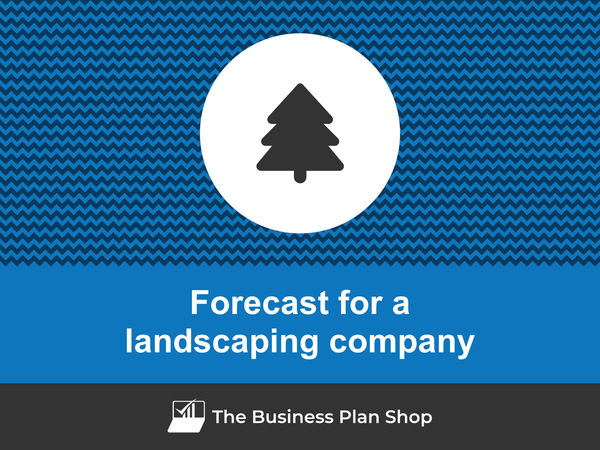
Developing and maintaining an up-to-date financial forecast for your landscaping company is key in order to maintain visibility on your business’s future cash flows.
If you feel overwhelmed at the thought of putting together a landscaping company financial forecast then don’t worry as this guide is here to help you.
We'll cover everything from: the main objectives of a financial forecast, the data you need to gather before starting, to the tables that compose it, and the tools that will help you create and maintain your forecast efficiently.
Let's get started!
Why create and maintain a financial forecast for a landscaping company?
In order to prosper, your business needs to have visibility on what lies ahead and the right financial resources to grow. This is where having a financial forecast for your landscaping company becomes handy.
Creating a landscaping company financial forecast forces you to take stock of where your business stands and where you want it to go.
Once you have clarity on the destination, you will need to draw up a plan to get there and assess what it means in terms of future profitability and cash flows for your landscaping company.
Having this clear plan in place will give you the confidence needed to move forward with your business’s development.
Having an up-to-date financial forecast for a landscaping company is also useful if your trading environment worsens, as the forecast enables you to adjust to your new market conditions and anticipate any potential cash shortfall.
Finally, your landscaping company's financial projections will also help you secure financing, as banks and investors alike will want to see accurate projections before agreeing to finance your business.
Need a solid financial forecast?
The Business Plan Shop does the maths for you. Simply enter your revenues, costs and investments. Click save and our online tool builds a three-way forecast for you instantly.

What information is used as input to build a landscaping company financial forecast?
A landscaping company's financial forecast needs to be built on the right foundation: your assumptions.
The data required to create your assumptions will depend on whether you are a new or existing landscaping company.
If you are creating (or updating) the forecast of an existing landscaping company, then your main inputs will be historical accounting data and operating metrics, and your team’s view on what to expect for the next three to five years.
If you are building financial projections for a new landscaping company startup, you will need to rely on market research to form your go-to-market strategy and derive your sales forecast.
For a new venture, you will also need an itemised list of resources needed for the landscaping company to operate, along with a list of equipment required to launch the venture (more on that below).
Now that you understand what is needed, let’s have a look at what elements will make up your landscaping company's financial forecast.
The sales forecast for a landscaping company
From experience, it usually makes sense to start your landscaping company's financial projection with the revenues forecast.
The inputs used to forecast your sales will include the historical trading data of your landscaping company (which can be used as a starting point for existing businesses) and the data collected in your market research (which both new ventures and existing businesses need to project their sales forward).
Your landscaping company's sales forecast can be broken down into two key estimates:
- The average price
- The number of monthly transactions
To assess these variables accurately, you will need to consider the following factors:
- You may see an increase in average price for your landscaping services due to a rise in demand for eco-friendly and sustainable practices. As more customers prioritize environmentally-friendly options, they may be willing to pay a higher price for your services.
- Changes in weather patterns could impact the number of monthly transactions for your landscaping business. For example, a particularly harsh winter may result in fewer customers seeking your services for snow removal, while a dry summer may lead to more customers requesting irrigation and lawn maintenance.
- The overall state of the economy may affect your average price and number of monthly transactions. During a recession, customers may be less willing to spend on non-essential services like landscaping, while a strong economy may lead to more disposable income and an increase in demand for your services.
- The availability of materials and equipment can impact your average price. For instance, if there is a shortage of certain materials, you may need to pay higher prices to source them, resulting in an increase in your average price for services that require those materials.
- Your reputation and word-of-mouth referrals may play a role in both your average price and number of monthly transactions. As your reputation grows, you may be able to charge higher prices for your services, and satisfied customers may refer their friends and family to you, leading to an increase in monthly transactions.
Once you have a sales forecast in place, the next step will be to work on your overhead budget. Let’s have a look at that now.
Need inspiration for your business plan?
The Business Plan Shop has dozens of business plan templates that you can use to get a clear idea of what a complete business plan looks like.

The operating expenses for a landscaping company
Once you know what level of sales you can expect, you can start budgeting the expenses required to operate your landscaping company on a daily basis.
Expenses normally vary based on how much revenue you anticipate (which is why, from experience, it is always better to start your forecast with the topline projection), and where your business is based.
Operating expenses for a landscaping company will include some of the following items:
- Staff costs: This includes the salaries and wages of your landscaping team, as well as any benefits and bonuses.
- Accountancy fees: As a business owner, you'll need to hire an accountant to help you manage your finances and file your taxes correctly.
- Insurance costs: It's important to have insurance for your landscaping business to protect yourself and your employees from any accidents or damages that may occur on the job.
- Software licenses: You may need to purchase software licenses for programs such as design software, accounting software, or project management software to help run your business more efficiently.
- Banking fees: You'll need to have a business bank account to manage your finances, which may come with monthly fees or transaction fees.
- Vehicle expenses: Your landscaping company may require vehicles for transporting equipment and materials, which will incur expenses such as gas, maintenance, and insurance.
- Equipment rental or leasing: In addition to purchasing equipment, you may also need to rent or lease equipment for specific projects, which will add to your operating expenses.
- Marketing and advertising: It's important to market and advertise your landscaping business to attract new customers. This may include expenses such as creating a website, printing business cards, or running ads.
- Office supplies: As a business owner, you'll need to purchase office supplies such as paper, pens, and ink cartridges to keep your business running smoothly.
- Training and development: It's important to invest in the training and development of your employees to improve their skills and keep up with industry trends.
- Rent or lease for office or storage space: Depending on the size of your business, you may need to rent or lease office or storage space for your equipment and supplies.
- Utilities: Your landscaping business will incur expenses for utilities such as electricity, water, and internet.
- Legal fees: As a business owner, you may need to consult a lawyer for legal advice or assistance with contracts and agreements.
- Uniforms and safety gear: Your employees may require uniforms or safety gear to wear while working, which will add to your operating expenses.
- Vehicle and equipment maintenance: Regular maintenance for your vehicles and equipment is necessary to keep them in good working condition, which will incur expenses.
This list will need to be tailored to the specificities of your landscaping company, but should offer a good starting point for your budget.
What investments are needed to start or grow a landscaping company?
Once you have an idea of how much sales you could achieve and what it will cost to run your landscaping company, it is time to look into the equipment required to launch or expand the activity.
For a landscaping company, capital expenditures and initial working capital items could include:
- Landscaping equipment: This includes items such as lawn mowers, leaf blowers, trimmers, and other tools necessary for maintaining and enhancing outdoor spaces. These are essential for a landscaping company and will likely be a significant expense in your forecast.
- Trucks and trailers: As a landscaping company, you will need reliable transportation to get your equipment and team to job sites. This may include purchasing or leasing trucks and trailers to transport your equipment and materials.
- Irrigation systems: Many landscaping projects involve installing irrigation systems to keep plants and lawns watered. These can be a significant expense for a company, but they are essential for providing quality services to clients.
- Greenhouse or nursery: Depending on the services your landscaping company offers, you may need to invest in a greenhouse or nursery to grow plants and flowers for your projects. This can be a large capital expenditure, but it can also save money in the long run by providing a source for your own plants.
- Hardscape materials: In addition to plants and flowers, many landscaping projects involve hardscape elements such as pavers, stones, and other materials. These can be costly, but they are necessary for creating beautiful outdoor spaces for clients.
Again, this list will need to be adjusted according to the specificities of your landscaping company.
Need a convincing business plan?
The Business Plan Shop makes it easy to create a financial forecast to assess the potential profitability of your projects, and write a business plan that’ll wow investors.

The financing plan of your landscaping company
The next step in the creation of your financial forecast for your landscaping company is to think about how you might finance your business.
You will have to assess how much capital will come from shareholders (equity) and how much can be secured through banks.
Bank loans will have to be modelled so that you can separate the interest expenses from the repayments of principal, and include all this data in your forecast.
Issuing share capital and obtaining a bank loan are two of the most common ways that entrepreneurs finance their businesses.
What tables compose the financial plan for a landscaping company?
Now let's have a look at the main output tables of your landscaping company's financial forecast.
The projected profit & loss statement
The projected profit & loss shows how profitable your landscaping company is likely to be in the years to come.
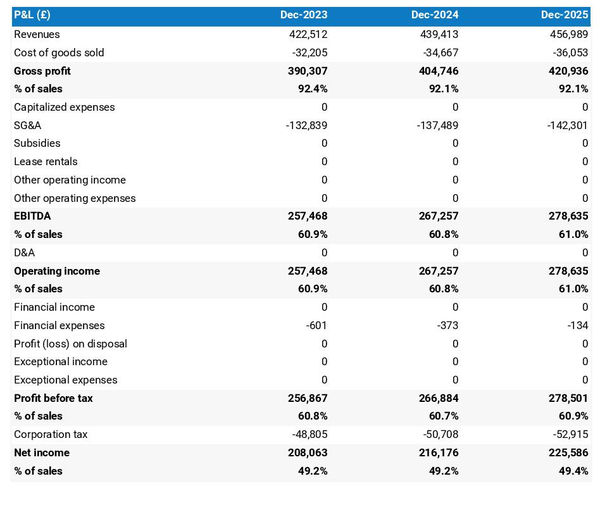
For your landscaping company to be financially viable, your projected P&L should ideally show:
- Sales growing above inflation (the higher the better)
- Profit margins which are stable or expanding (the higher the better)
- A net profit at the end of each financial year (the higher the better)
This is for established landscaping companies, there is some leniency for startups which will have numbers that will look a bit different than existing businesses.
The projected balance sheet
Your landscaping company's forecasted balance sheet enables you to assess your financial structure and working capital requirements.
It is composed of three types of elements: assets, liabilities and equity:
- Assets: represent what the business owns and uses to produce cash flows. It includes resources such as cash, equipment, and accounts receivable (money owed by clients).
- Liabilities: represent funds advanced to the business by lenders and other creditors. It includes items such as accounts payable (money owed to suppliers), taxes due and loans.
- Equity: is the combination of what has been invested by the business owners and the cumulative profits and losses generated by the business to date (which are called retained earnings). Equity is a proxy for the value of the owner's stake in the business.
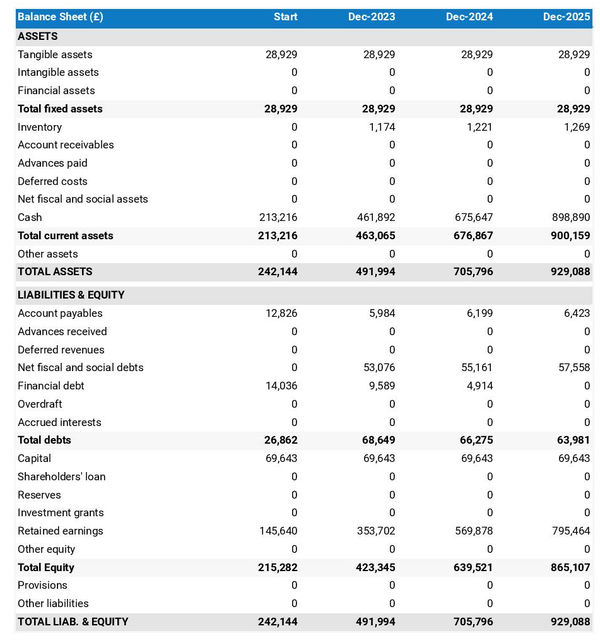
The cash flow projection
The cash flow forecast of your landscaping company will show how much cash the business is expected to generate or consume over the next three to five years.
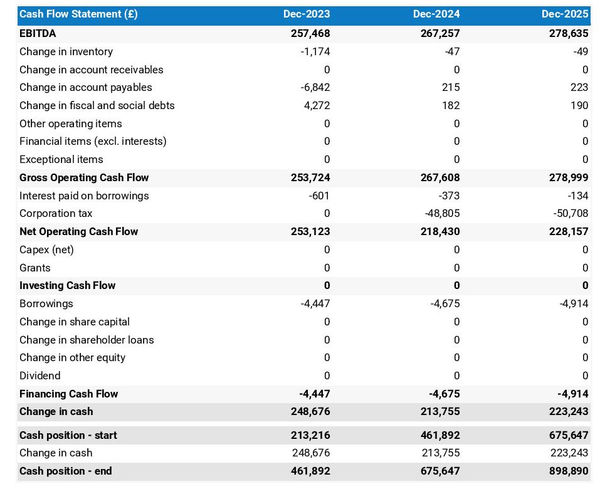
There are multiple ways of presenting a cash flow forecast but from experience, it is better to organise it by nature in order to clearly show these elements:
- Operating cash flow: how much cash is generated by the landscaping company's operations
- Investing cash flow: what is the business investing to expand or maintain its equipment
- Financing cash flow: is the business raising additional funds or repaying financiers (debt repayment, dividends)
Your cash flow forecast is the most important element of your overall financial projection and that’s where you should focus your attention to ensure that your landscaping company is adequately funded.
Note: if you are preparing a financial forecast in order to try to secure funding, you will need to include both a yearly and monthly cash flow forecast in your landscaping company's financial plan.
Need a solid financial forecast?
The Business Plan Shop does the maths for you. Simply enter your revenues, costs and investments. Click save and our online tool builds a three-way forecast for you instantly.

Which tool should you use to create your landscaping company's financial forecast?
Using the right tool or solution will make the creation of your landscaping company's financial forecast much easier than it sounds. Let’s explore the main options.
Using online financial forecasting software to build your landscaping company's projections
The modern and easiest way is to use an online financial forecasting tool such as the one we offer at The Business Plan Shop.
There are several advantages to using specialised software:
- You can easily create your financial forecast by letting the software take care of the financial calculations for you without errors
- You have access to complete financial forecast templates
- You get a complete financial forecast ready to be sent to your bank or investors
- You can easily track your actual financial performance against your financial forecast, and recalibrate your forecast as the year goes by
- You can create scenarios to stress test your forecast's main assumptions
- You can easily update your forecast as time goes by to maintain visibility on future cash flows
- You have a friendly support team on standby to assist you when you are stuck
- It’s cost-efficient and much cheaper than using an accountant or consultant (see below)
If you are interested in this type of solution, you can try our projection software for free by signing up here.
Hiring a financial consultant or chartered accountant
Hiring a consultant or chartered accountant is also an efficient way to get a professional landscaping company financial projection.
As you can imagine, this solution is much more expensive than using software. From experience, the creation of a simple financial forecast over three years (including a balance sheet, income statement, and cash flow statement) is likely to start around £700 or $1,000 excluding taxes.
The indicative estimate above, is for a small business, and a forecast done as a one-off. Using a financial consultant or accountant to track your actuals vs. forecast and to keep your financial forecast up to date on a monthly or quarterly basis will naturally cost a lot more.
If you choose this solution, make sure your service provider has first-hand experience in your industry, so that they may challenge your assumptions and offer insights (as opposed to just taking your figures at face value to create the forecast’s financial statements).
Why not use a spreadsheet such as Excel or Google Sheets to build your landscaping company's financial forecast?
Creating an accurate and error-free landscaping company financial forecast on Excel (or any spreadsheet) is very technical and requires both a strong grasp of accounting principles and solid skills in financial modelling.
Most entrepreneurs lack the expertise required to create an accurate financial forecast using spreadsheet software like Excel or Google Sheets. As a result, it is unlikely anyone will trust your numbers.
The second reason is that it is inefficient. Building forecasts on spreadsheets was the only option in the 1990s and early 2000s, nowadays technology has advanced and software can do it much faster and much more accurately.
This is why professional forecasters all use software. With the rise of AI, software is also becoming smarter at helping us detect mistakes in our forecasts and helping us analyse the numbers to make better decisions.
Finally, like everything with spreadsheets, tracking actuals vs. forecasts and updating your forecast as the year progresses is manual, tedious, error-prone, and time-consuming. Whereas financial forecasting software like The Business Plan Shop is built for this.
Need a convincing business plan?
The Business Plan Shop makes it easy to create a financial forecast to assess the potential profitability of your projects, and write a business plan that’ll wow investors.

Use our financial projection templates for inspiration
The Business Plan Shop has dozens of financial forecasting templates available.
Our examples contain both the financial forecast, and a written business plan which presents, in detail, the company, the team, the strategy, and the medium-term objectives.
Whether you are just starting out or already have your own landscaping company, looking at our template is always a good way to get ideas on how to model financial items and what to write when creating a business plan to secure funding.
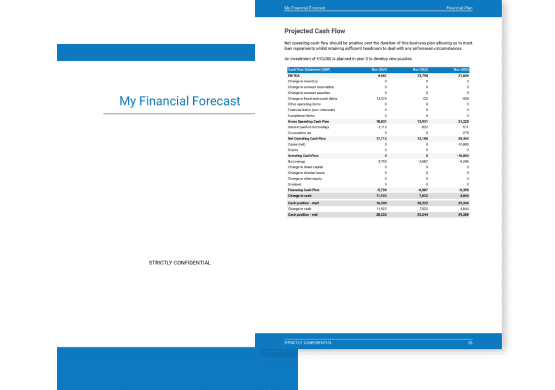
Takeaways
- A financial forecast shows expected growth, profitability, and cash generation metrics for your landscaping company.
- Tracking actuals vs. forecast and having an up-to-date financial forecast is key to maintaining visibility on your future cash flows.
- Using financial forecasting software is the modern way of creating and maintaining financial projections.
We hope that this guide helped you gain a clearer perspective on the steps needed to create the financial forecast for a landscaping company. Don't hesitate to contact us if you have any questions!
Need inspiration for your business plan?
The Business Plan Shop has dozens of business plan templates that you can use to get a clear idea of what a complete business plan looks like.

Also on The Business Plan Shop
Know someone who runs a landscaping company? Share our business guide with them!




